
Newgrange
Built some 5,300 years ago, this holy place is one of the oldest built structures in the world. Known in Gaelic as Uaimh na Gréine, 'the cave of the sun', Newgrange is a pagan monument, with a vaulted roof and a cruciform design. Its history is interwoven with intriguing myths and the mysteries of its construction. The lore of its past calls ever-growing numbers of visitors to this chamber of light. Newgrange is at the centre of an entire Boyne valley megalithic culture and religious ritual.
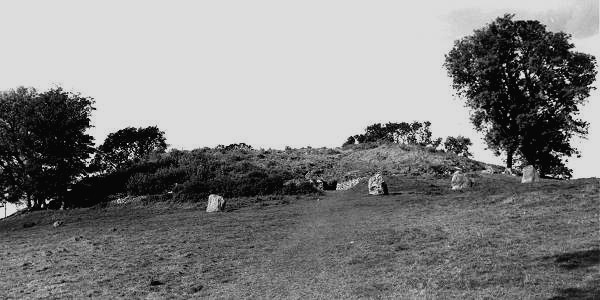
In early Irish mythology, Newgrange was not only the alleged burial place of the prehistoric Kings of Tara, but also the home of a race of Irish supernatural beings, known as 'Tuatha de Danann' : the people of the goddess Danu. Newgrange was also taken to be the house of the patriarchal god Dagda.
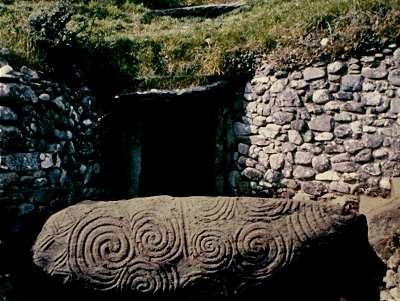
When it was discovered in 1699, the rock facing of the mound of this passage tomb had collapsed. The shimmering white quartz, irregularly shaped, and the round dark granite stones, neither of which are local, were found at the site. Ninety-seven curbstones were also found. Archaeologists have reconstructed the rock face of the mound and its entrance.
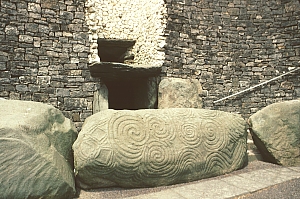
This passage tomb has a tunnel to the
central vaulted interior, which is oriented so that on the winter solstice
sunlight shines through the "roof box" above the entrance and streams
down the passage lighting the main chamber.
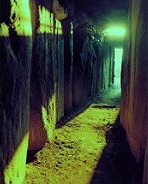
Tuatha De Danann, Lords of Light
a space reveals itself
in stone, eternities
joined to an origin
we remember our deaths:
these vertical bones unfold
light, a shadow breath
sacred and undefeated
![]()
TARA
The great, beautiful hill was dotted with seven duns, and in every dun were many buildings - all of them, of course, of wood, in those days - or of wood and metal. The greatest structure was the Mi Cuarta, the great banqueting hall, which was on the Ard Righ’s own dun. Each of the provincial kings had, on Tara, a house that was set aside for him when he came up to attend the great Parliament. There was a Grianan (sun house) for the provincial queens, and their attendants. The great Feis was held at Samhain (Hallowday). It lasted for three days before Samain and three days after.
"Samhain," pronounced SOW-IN
(sow-een) or SOW-EN (sow-en), is the compound word derived from the Gaelic
words "sam," meaning "summer" and "fuin," meaning
"end." So Samhain, or Samain, means literally "end of summer."
The Irish-English dictionary defines Samhain as: "All Hallowtide, the
feast of the dead in Pagan and Christian times, signaling the close of harvest
and start of winter." The Scottish Gaelis Dictionary defines it as "Hallowtide.
The feast of All Souls." So as you can see, Halloween is tied to the
Samhain, although today it's only a pale shadow of the original Celtic festival.

As from the great heart and centre of the Irish Kingdom, five great arteries or roads radiated from Tara to the various parts of the country the Slighe Cualann, which ran toward the present County Wicklow, the Slighe Mor, the great Western road, which ran via Dublin to Galway, the Slight Asail which ran near the present Mullingar, the Slighe Dala which ran southwest, and the Slighe Midluachra, the Northern road. "Great, noble and beautiful truly was our Tara of the Kings."
![]()
STONE CIRCLES
Legacy of the Ancients do they play any part in the science of Archaeoastronomy?
![]()
STONEHENGE
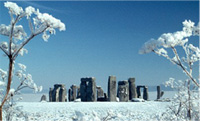
URAGH
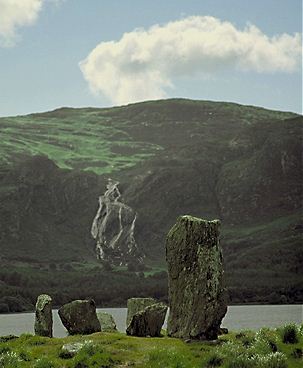
LOUGH GUR
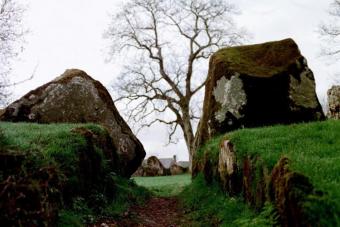
The Entrance to the HUGEST stone circle I saw in Ireland, stay tuned for more pics as I update
The stone age settlement at Lough Gur dates back some 6,000 years. The area is surrounded by standing stones, burial mounds and megalithic tombs.
DROMBEG/DRUIDS ALTER
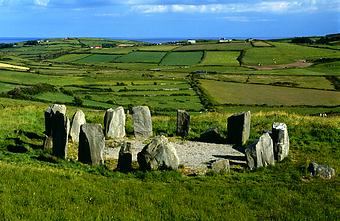
The Druid's Altar, is located on the edge of a rocky terrace with views to the sea about a mile away. The word Drombeg means 'the small ridge'.Of the original 17 pillars of smooth-sided local sandstone erected in a circle of 31ft in diameter, only 13 remain. To the left of the north-east entrance is a portal stone 7ft 2in high; its opposite is the 6ft 10in long recumbent* which has two egg-shaped cup-marks (one with a ring around it). The circle stones have been shaped to slope upwards to the recumbent itself. The midpoint of this stone was set in line with the winter soltice sunset viewed in a conspicuous notch in the distant hills; the alignment is good but not precise. Excavations in 1957 and 1958 revealed cremated bones in a deliberately broken pot wrapped with thick cloth and buried near the centre of the circle along with 80 other smashed shards, four bits of shale and a collection of sweepings from a pyre.
*Recumbent Stone Circles are a distinctive type of stone circle. Two stones, often the tallest ones, flank a large recumbent stone lying on its side, weighing many tons. Mostly facing South West but with regional variations, its purpose is uncertain, but it is thought to be a level "frame" over which to observe the movements of the moon.
About 40yds to the west
of the circle are the remains of two stone-built prehistoric huts joined by
a common doorway. The smaller has a cooking place 5ft x 3ft 6in on its eastern
side; this was still in use in the 5th century AD. This prehistoric kitchen
had a flagged trough in which water was boiled by dropping red-hot stones
into it. Recent tests confirmed that using this method, 70 or more gallons
of water could be boiled for almost three hours OR almost 350 litres could
be boiled within 15 minutes of the stones being dropped in. The presence of
the stone circle, huts, and cooking-place suggests that annual or seasonal
gatherings took place at a sacred site down to the 5th century AD, the dating
obtained for the cooking place.
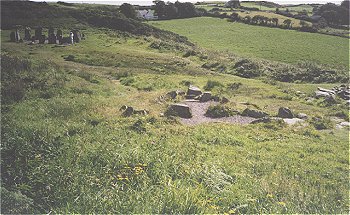
|

|
|
Here you can see the Druids Alter, the edge of the huts, and catch a glimpse of the view above. |
Here is a close-up of the cooking pit in one of the stone age huts, when you climb down in there, and look up to take in the view, its a breathtaking experience. (scroll back up to check it out again) |
![]()

![]()